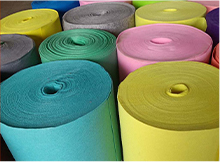Exploring the Use of Felt Materials for Enhanced Sound Absorption Properties and Applications
The Role of Felt in Sound Absorption A Comprehensive Overview
In an age where noise pollution is increasingly becoming a concern, the search for effective sound absorption materials is more critical than ever. One such versatile material that has gained attention for its acoustic properties is felt. Made from densely packed fibers, felt is not only used in crafts and garments but also serves as an exceptional sound-absorbing medium. This article delves into the characteristics of felt, its mechanisms for sound absorption, and its applications in various environments.
Understanding Felt
Felt is a non-woven fabric formed by compressing and matting fibers, typically wool, but can also be made from synthetic materials or blends. The structure of felt consists of numerous intertwined fibers which create a dense yet porous composition. This unique structure significantly contributes to its sound absorption capabilities. The thickness, density, and type of fiber used can all influence the acoustic performance of felt, making it a customizable solution for specific soundproofing needs.
Mechanisms of Sound Absorption
The primary way felt absorbs sound is through a combination of absorption and diffusion. When sound waves encounter the felt material, some of the energy is absorbed by the fibers, converting it into a small amount of heat energy. This process reduces the intensity of sound waves, effectively lowering noise levels in a given space. Additionally, the porous nature of felt allows sound waves to penetrate the material, dispersing them in various directions and further diminishing their energy.
The absorption properties of felt can be quantified by determining its Noise Reduction Coefficient (NRC). This coefficient measures how well a material can absorb sound, with higher values indicating better performance. Felt typically exhibits a favorable NRC when used in appropriate thickness and density configurations, making it suitable for applications where sound control is vital.
Applications of Felt in Acoustic Design
felt for sound absorption

Felt is utilized in various applications ranging from residential to commercial spaces. In homes, felt is often used in soundproofing walls, ceilings, and floors to create quieter environments. For instance, felt acoustic panels can be mounted on walls to reduce echo in living rooms or home theaters, enhancing the overall listening experience.
In commercial settings, such as offices and conference rooms, felt plays a crucial role in improving acoustic comfort. Open office designs, while trendy, can create challenges with noise distractions. By integrating felt products, such as acoustic tiles and partitions, businesses can create quiet zones that foster productivity and collaboration. Furthermore, felt is used in auditoriums and music studios where sound clarity is paramount, helping to fine-tune acoustics for optimal sound quality.
Sustainability and Aesthetic Appeal
Another significant benefit of using felt for sound absorption is its sustainability. Many felt products are made from natural fibers, such as wool, which are renewable and biodegradable. As the demand for eco-friendly materials rises, felt stands out as a responsible choice for environmentally-conscious consumers and designers.
Moreover, felt comes in various colors, textures, and designs, allowing it to complement different interior aesthetics while providing functional benefits. This versatility ensures that sound absorption solutions do not compromise on style.
Conclusion
Felt has emerged as a valuable material in the quest for effective sound absorption. Its unique fiber structure allows it to absorb sound efficiently while being adaptable to various applications across different environments. With growing consciousness about noise pollution and the need for acoustic comfort, felt presents an excellent solution that marries functionality with sustainability and aesthetic appeal. As industries continue to innovate, the role of felt in acoustic design will undoubtedly expand, paving the way for quieter, more enjoyable spaces in our daily lives.
-
What Makes Felt a Great Choice?NewsNov.19,2024
-
Total Mixed Ration (TMR) Feed for CattleNewsNov.19,2024
-
The Ultimate Guide for Felt Polishing WheelsNewsNov.19,2024
-
Industrial Felt for Various ApplicationsNewsNov.19,2024
-
Felt Makeup Bags and Inserts BagsNewsNov.19,2024
-
Choosing the Right Hotel TowelsNewsNov.19,2024
-
Your Go-To Guide For Affordable Wholesale Wool FeltsNewsOct.31,2024







